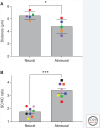Stem Cells and the Bird Cochlea-Where Is Everybody?
- PMID: 30249599
- PMCID: PMC6444699
- DOI: 10.1101/cshperspect.a033183
Stem Cells and the Bird Cochlea-Where Is Everybody?
Abstract
In sharp contrast to the adult mammalian cochlea, which lacks regenerative ability, the mature avian cochlea, or basilar papilla (BP) is capable of complete recovery from hearing loss after damage. Avian sensory hair cell regeneration relies on rousing quiescent supporting cells to proliferate or transdifferentiate after hair cell death. Unlike mammalian cochlear supporting cells, which have clearly defined subtypes, avian BP supporting cells are deceptively indistinguishable and molecular markers have yet to be identified. Despite the importance of supporting cells as the putative stem cells in avian regeneration, it is unknown whether all supporting cells possess equal capability to give rise to a hair cell or if a specialized subpopulation exists. In this perspective, we reinvigorate the concept of a stem cell in the BP, and form comparisons to other regenerating tissues that show cell-cycle reentry after damage. Special emphasis is given to the structure of the BP and how anatomy informs both the potential, intrinsic heterogeneity of the supporting cell layer as well as the choice between mitotic and nonmitotic regenerative strategies.
Copyright © 2019 Cold Spring Harbor Laboratory Press; all rights reserved.
Figures



References
-
- Adler HJ, Raphael Y. 1996. New hair cells arise from supporting cell conversion in the acoustically damaged chick inner ear. Neurosci Lett 205: 17–20. - PubMed
-
- Adler HJ, Komeda M, Raphael Y. 1997. Further evidence for supporting cell conversion in the damaged avian basilar papilla. Int J Dev Neurosci 15: 375–385. - PubMed
-
- Baird RA, Steyger PS, Schuff NR. 1996. Mitotic and nonmitotic hair cell regeneration in the bullfrog vestibular otolith organs. Ann NY Acad Sci 781: 59–70. - PubMed
Publication types
MeSH terms
LinkOut - more resources
Full Text Sources
Other Literature Sources
Medical
